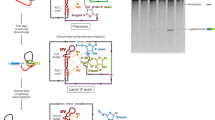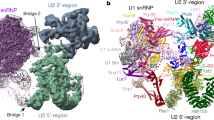Abstract
Pairing of a consensus sequence of the precursor (pre)-mRNA intron with a short region of the U2 small nuclear (sn)RNA during assembly of the eukaryotic spliceosome results in formation of a complementary helix of seven base pairs with a single unpaired adenosine residue. The 2′ OH of this adenosine, called the branch site, brings about nucleophilic attack at the pre-mRNA 5′ splice site in the first step of splicing. Another feature of this pairing is the phylogenetic conservation of a pseudouridine (ψ) residue in U2 snRNA nearly opposite the branch site. We show that the presence of this ψ in the pre-mRNA branch-site helix of Saccharomyces cerevisiae induces a dramatically altered architectural landscape compared with that of its unmodified counterpart. The ψ-induced structure places the nucleophile in an accessible position for the first step of splicing.
This is a preview of subscription content, access via your institution
Access options
Subscribe to this journal
Receive 12 print issues and online access
$189.00 per year
only $15.75 per issue
Buy this article
- Purchase on Springer Link
- Instant access to full article PDF
Prices may be subject to local taxes which are calculated during checkout






Similar content being viewed by others
References
Moore, M., Query, C. & Sharp, P. in The RNA World (eds Gesteland, R.F. & Atkins, J.F.) 303–357 (Cold Spring Harbor Laboratory Press, Cold Spring Harbor; 1993).
Madhani, H.D. & Guthrie, C. A novel base-pairing interaction between U2 and U6 snRNAs suggests a mechanism for the catalytic activation of the spliceosome. Annu. Rev. Genet. 28, 1–26 (1994).
Valadkhan, S. & Manley, J.L. Splicing-related catalysis by protein-free snRNAs. Nature 413, 701–707 (2001).
Lane, B.G. in Modification and Editing of RNA (eds Grosjean, H. & Benne, R.) 1–20 (ASM Press, Washington, D.C.; 1998).
Yu, Y.-T., Shu, M.-D. & Steitz, J.A. Modification of U2 snRNA are required for snRNP assembly and pre-mRNA splicing. EMBO J. 17, 5783–5795 (1998).
Reddy, R. & Busch, H. in Structure and Function of Major and Minor Small Nuclear Ribonucleoprotein Particles (ed. Birnstiel, M.L.) 1–37 (Springer-Verlag Press, Berlin; 1988).
Patton, J., Jacobsen, M. & Pederson, T. Pseudouridine formation in small nuclear RNA. Proc. Natl. Acad. Sci. USA 91, 3324–3328 (1994).
Gu, J., Patton, J., Shimba, S. & Reddy, R. Localization of modified nucleotides in Schizosaccharomyces pombe spliceosomal small nuclear RNAs: modified nucleotides are clustered in functionally important regions. RNA 2, 909–918 (1996).
Massenet, S. et al. Pseudouridine mapping in spliuceosomal U snRNAs (snRNAs) reveals that pseudouridine synthase pus1p exhibits a dual substrate specificity for U2 snRNA and tRNA. Mol. Cell. Biol. 19, 2142–2154 (1999).
McPheeters, D.S. & Abelson, J. Mutational analysis of the yeast U2 snRNA suggests a structural similarity to the catalytic core of group I introns. Cell 71, 819–831 (1992).
Pascolo, E. & Seraphin, B. The branchpoint residue is recognized during commitment complex formation before being bulged out of the U2 snRNA–pre-mRNA duplex. Mol. Cell. Biol. 17, 3469–3476 (1997).
Wu, J. & Manley, J.L. Mammalian pre-mRNA branch site selection by U2 snRNP involves base-pairing. Genes Dev. 3, 1553–1561 (1989).
Newby, M.I. & Greenbaum, N.L. A conserved pseudouridine modification in eukaryotic U2 snRNA induces a change in branch site architecture. RNA 7, 833–845 (2001).
Zagorowska, I. & Adamiak, R.W. 2-Aminopurine labeled RNA bulge loops. Synthesis and thermodynamics. Biochimie 78, 123–130 (1996).
Rachofsky, E.L., Osman, R. & Ross, J.B.A. Probing structure and dynamics of DNA with 2-aminopurine. Biochemistry 40, 946–956 (2001).
Kulinski, T. et al. Introductory data on dynamics of RNA bulge duplexes. 2-aminopurine labeled adenosine loops. Collect. Czech. Chem. Commun. 61, S265–S267 (1996).
Smith, J.S. & Nikonowicz, E.P. NMR structure and dynamics of an RNA motif common to the spliceosome branch-point helix and the RNA-binding site for phage GA coat protein. Biochemistry 37, 13486–13498.
Jucker, F.M., Heus, H.A., Yip, P.F., Moors, E.H.M. & Pardi, A. A network of heterogeneous hydrogen bonds in GNRA tetraloops. J. Mol. Biol. 264, 968–980 (1996).
Nissen, P., Ippolito, J.A., Ban, N., Moore, P.B. & Steitz, T.A. RNA tertiary interactions in the large ribosomal subunit: the A-minor motif. Proc. Natl. Acad. Sci. USA 98, 4899–4903 (2001).
Borer, P.N. et al. Proton NMR and structural features of a 24-nucleotide RNA hairpin. Biochemistry 34, 6488–6503 (1995).
Lynch, S.R. & Puglisi, J.D. Structure of a eukaryotic decoding region A-site RNA. J. Mol. Biol. 306, 1023–1035 (2001).
Greenbaum, N.L., Radhakrishnan, I., Patel, D.J. & Hirsh, D. Solution structure of the donor site of a trans-splicing RNA. Structure 4, 725–733 (1996).
Ennifar, E. et al. The crystal structure of the dimerization initiation site of genomic HIV-1 RNA reveals an extended duplex with two adenine bulges. Structure 7, 1439–1449 (1999).
Portman, S., Grimm, S., Workman, C., Usman, N. & Egli, M. Crystal structures of an A-form duplex with single-adenosine bulges and a conformational basis for site-specific RNA self-cleavage. Chem. Biol. 3, 173–184 (1996).
Hermann, T. & Patel, D. RNA bulges as architectural and recognition motifs. Structure 8, R47–R54 (2000).
Berglund, J.A., Rosbash, M. & Schultz, S.C. Crystal structure of a model branchpoint U2 snRNA duplex containing bulged adenosines. RNA 7, 682–691 (2001).
Davis, D. & Poulter, C. 1H-15N NMR studies of Escherichia coli tRNAphe from hisT mutants: a structural role for pseudouridine. Biochemistry 30, 4223–4231 (1991).
Yarian, C.S. et al. Structural and functional roles of the N1- and N3-protons of ψ at tRNA's position 39. Nucleic Acids Res. 27, 3543–3549 (1999).
Newby, M.I. & Greenbaum, N.L. Investigation of Overhauser effects between pseudouridine and water protons in RNA helices. Proc. Natl. Acad. Sci. USA 99, 12697–12702 (2002).
Hornig, H., Aebi, M. & Weissman, C. Effect of mutations at the lariat branch acceptor site on β-globin pre-messenger RNA splicing in vitro. Nature, 324, 589–591 (1986).
Query, C., Strobel, S. & Sharp, P. Three recognition events at the branch site adenosine. EMBO J. 15, 1392–1402 (1996).
Michel F., Hanna, M., Green, R., Bartel. D.P. & Szostak, J.W. The guanosine binding site of the Tetrahymena ribozyme. Nature 342, 391–395 (2002).
Yarus, M., Illangesekare, M. & Christian, E. Selection of small molecules by the Tetrahymena catalytic center. J. Mol. Biol. 222, 995–1012 (1991).
Kitamura, A. et al. Solution structure of an RNA fragment with the P7/P9.0 region and the 3′-terminal guanosine of the Tetrahymena group I intron. RNA 8, 440–451 (2002).
Been, M.D., & Perrotta, A.T. Group I intron self-splicing with adenosine: evidence for a single nucleoside-binding site. Science 252, 434–437 (1991).
Zhang, L. & Doudna, J.A. Structural insights into group II intron catalysis and branch site selection. Science 295, 2084–2087 (2002).
Massenet, S. & Branlant, C. A limited number of pseudouridine residues in the human atac spliceosomal U snRNAs as compared to human major spliceosomal U snRNAs. RNA 5, 1495–1503 (1999).
Wijmenga, S., Mooren, M. & Hilbers, C. in NMR of Macromolecules: A Practical Approach (ed. Roberts, G.C.K.) 207–288 (Oxford University Press, Oxford; 1993).
Hwang, T.-L., Mori, S., Shaka, A.J. & van Zijl, P.C.M. Application of phase-modulated CLEAN chemical EXchange spectroscopy (CELANEX-PM) to detect water-protein proton exchange and intermolecular NOEs. J. Am. Chem. Soc. 119, 6203–6204 (1997).
Rice, L.M. & Brünger, A.T. Torsion angle dynamics — reduced variable conformational sampling enhances crystallographic structure refinement. Proteins 19, 277–290 (1994).
Stein, E.G., Rice, L.M. & Brünger, A.T. Torsion-angle molecular dynamics as a new efficient tool for NMR structure calculation. J. Magn. Reson. 124, 154–164 (1997).
Brünger, A.T. X-PLOR Version 3.851: A System for Crystallography and NMR (Yale University Press, New Haven; 1996).
Ferrin, T.E., Huang, C.C., Jarvis, L.E. & Langridge, R. The MIDAS display system. J. Mol. Graph. 6, 13–27 (1988).
Huang, C.C., Pettersen, E.F., Klein, T.E., Ferrin, T.E. & Langridge, R. Conic: a fast renderer for space-filling molecules with shadows. J. Mol. Graph. 9, 230–236 (1991).
Varani, G., Aboul-ela, F. & Allain, F.H.-T. NMR investigation of RNA structure. Prog. Nucl. Magn. Reson. Spec. 29, 51–127 (1996).
Legault, P. & Pardi, A. 31P chemical shift as a probe of structural motifs in RNA. J. Magn. Reson. B 103, 82–86 (1994).
Hall, K. & McLaughlin, L. Properties of U1/mRNA 5′ splice site duplex containing pseudouridine as measured by thermodynamic and NMR methods. Biochemistry 30, 1795–1801 (1991).
Acknowledgements
We thank K. Hall for helpful discussions about ψ and 2AP, M. Zawrotny for computer support and the laboratory of D. Patel, in particular A. Gorin, for assistance with the initial structure calculation of ψBP. We also thank Y.-T. Yu for sharing new data with us before publication. We acknowledge the National High Magnetic Field Laboratory (Tallahassee, Florida) for NMR facilities and support. M.I.N. is a recipient of a Molecular Biophysics fellowship funded by National Science Foundation Research Training Grant. This work was supported by a National Institutes of Health Grant to N.L.G.
Author information
Authors and Affiliations
Corresponding author
Ethics declarations
Competing interests
The authors declare no competing financial interests.
Rights and permissions
About this article
Cite this article
Newby, M., Greenbaum, N. Sculpting of the spliceosomal branch site recognition motif by a conserved pseudouridine. Nat Struct Mol Biol 9, 958–965 (2002). https://doi.org/10.1038/nsb873
Received:
Accepted:
Published:
Issue Date:
DOI: https://doi.org/10.1038/nsb873
This article is cited by
-
A single m6A modification in U6 snRNA diversifies exon sequence at the 5’ splice site
Nature Communications (2021)
-
Drosophila dyskerin is required for somatic stem cell homeostasis
Scientific Reports (2017)
-
Catalytic spliceosome captured
Nature (2016)
-
Gene expression regulation mediated through reversible m6A RNA methylation
Nature Reviews Genetics (2014)
-
A horizontal gene transfer supported the evolution of an early metazoan biomineralization strategy
BMC Evolutionary Biology (2011)



